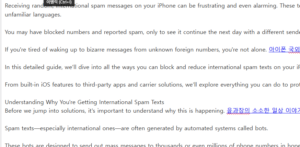Receiving random, international spam messages on your iPhone can be frustrating and even alarming. These texts often come at odd hours, contain suspicious links, or use unfamiliar languages.

You may have blocked numbers and reported spam, only to see it continue the next day with a different sender.
If you’re tired of waking up to bizarre messages from unknown foreign numbers, you’re not alone. 아이폰 국외발신 스팸 문자 차단
In this detailed guide, we’ll dive into all the ways you can block and reduce international spam texts on your iPhone.
From built-in iOS features to third-party apps and carrier solutions, we’ll explore everything you can do to protect your peace and keep your Messages app clean.
Understanding Why You’re Getting International Spam Texts
Before we jump into solutions, it’s important to understand why this is happening. 윤과장의 소소한 일상 이야기
Spam texts—especially international ones—are often generated by automated systems called bots.
These bots are designed to send out mass messages to thousands or even millions of phone numbers in hopes that a few people will click a link or respond.
Unfortunately, your number might have been leaked or randomly targeted.
This kind of spam can bypass simple blocks because the sender ID keeps changing.
That’s why blocking one number rarely solves the problem.
The good news is that there are smarter ways to protect your iPhone from these nuisances.
Use the Built-in Message Filtering Feature
Apple has a built-in feature that helps reduce spam, and many users don’t even know it exists.
Go to Settings > Messages > Unknown & Spam.
Then toggle Filter Unknown Senders ON.
Once you do this, any message from a number not saved in your contacts will go into a separate tab.
This doesn’t block the message, but it does keep it out of your main inbox.
You won’t get notifications for those either, which already reduces daily distractions.
This is especially helpful if you don’t get texts from unfamiliar numbers often.
Report Spam to Apple Directly
When you receive a suspicious text, your iPhone may give you the option to report it.
If the message came from an unknown sender and looks suspicious, you’ll see a “Report Junk” link beneath the message.
Tap that, and then select Delete and Report Junk.
This notifies both Apple and your carrier about the message.
While this won’t block future messages instantly, Apple uses this data to improve its filters.
Think of it like voting spam off the island.
The more reports a spammer gets, the better chance Apple has of keeping it from reaching others.
Block the Individual Sender (If It’s Consistent)
While most spam messages come from changing numbers, some use a specific email or number repeatedly.
In that case, blocking that sender can help reduce volume.
Open the message.
Tap the sender’s name or number at the top.
Then tap Info > Block this Caller.
It’s a manual process and not always effective for large-scale spam, but it’s a quick win when you spot repeat offenders.
This is best used when one number is targeting you consistently.
Disable iMessage From Receiving Emails (Reduce iMessage Spam)
Sometimes spam comes through iMessage, not SMS.
These often come from strange email addresses instead of phone numbers.
Here’s how to limit that:
Go to Settings > Messages > Send & Receive.
Under “You can receive iMessages to and reply from,” uncheck any email addresses you don’t use.
Only leave your main phone number checked.
This prevents spammers from using email-to-iMessage gateways to reach you.
It’s a small change that can dramatically reduce foreign spam messages coming through Apple’s system.
Use Third-Party Spam Filtering Apps
If you’re still seeing spam slip through, it might be time to bring in reinforcements.
Apps like Truecaller, Hiya, and RoboKiller are designed to block unwanted texts and calls.
They use crowd-sourced data and real-time analysis to detect spam before it hits your phone.
Here’s how to use one effectively:
Download the app from the App Store.
Follow the app’s instructions to give it access to your Messages.
Then go to Settings > Messages > Unknown & Spam.
Under “SMS Filtering,” select the app you installed.
From that point forward, it will scan incoming texts and route spam into the junk folder.
These apps are especially useful if you’re being bombarded multiple times a day.
Ask Your Carrier for Spam Protection
Most mobile carriers offer some level of spam filtering or blocking at the network level.
AT&T has Call Protect.
Verizon offers Call Filter.
T-Mobile provides Scam Shield.
Though the names focus on calls, they also filter suspicious texts.
Visit your carrier’s website or call customer service to activate these protections.
They often include spam-blocking for both calls and SMS—even from international numbers.
Some services are free, while others may require a subscription.
Still, it’s often worth it if the spam is constant and disruptive.
Use Focus Mode to Hide Unknown Notifications
If spam messages are interrupting your focus or sleep, you can use Focus Mode as a temporary shield.
Go to Settings > Focus, and create a new custom focus like “No Spam.”
Under People, allow only contacts.
This way, only messages from saved contacts will generate notifications.
Spam texts will still arrive, but you won’t see them until you choose to.